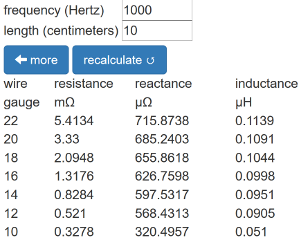Wire Inductance and Resistance Calculator
What does this calculator do?
Copper is not a perfect conductor. On the contrary, wires have a certain amount of resistance that increases with length and decreases with diameter. If we wind a wire into a coil it obviously creates inductance, but even a straight piece of wire or a component lead has some parasitic inductance caused by the magnetic field that it creates.
The amount of reactance the inductance creates is directly proportional to frequency. The calculator computes this reactance for various gauges of hookup wire. It assumes that the wire is perfectly straight and that current is evenly distributed throughout the copper metal, which is approximately true for audio frequencies. At higher frequencies there is appreciable skin effect, where most of the current travels on the wire surface, and under these conditions the inductance and the reactance are less.1
For audio applications, particularly in vacuum-tube amplifiers, it's important to note the units: milliohms, micro-ohms, and microhenries. In the context of guitar amp components measured in kilo-ohms and henries, these quantities are quite small. For radio-frequency and lightning-protection applications, on the other hand, a few milliohms can go a long way.
Reference
1Military Handbook, Grounding, Bonding, and Shielding for Electronic Equipment and Facilities (MIL-HDBK-419A), Vol 1, 29 Dec 1987.

|
From system design concepts to individual stage operation, an all-new examination of Bassman electronics. |
 Launch me!
Launch me!





